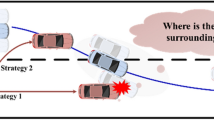Abstract
Motion planning in an uncertain dynamic environment is a complex task, especially when obstacles move in a non-linear fashion. In this paper obstacles refer to other vehicles, pedestrians, bicycles, riders etc. In such cases, predicting the obstacles’ kinematics requires a forecast of the obstacles’ trajectories. The choice of the forecast time horizon is critical, especially in conflict scenarios where an accident can be avoided only by adjusting the maneuvers of one of the vehicles. In this paper, we present an approach for establishing optimal forecast time based on Maneuverability Maps that determine a vehicle's possible maneuvers. The approach can be used as guidance for human drivers and can also be implemented in the control system of autonomous vehicles. Simulation results indicate that optimizing the forecast time in a conflict scenario can reduce the probability for an accident.












Similar content being viewed by others
References
Katrakazas C, Quddus M, Chen W-H, Deka L (2015) Real-time motion planning methods for autonomous on-road driving: state-of-the-art and future research directions. Transp Res Part C: Emerg Technol. https://doi.org/10.1016/J.TRC.2015.09.011
Fulgenzi C, Spalanzani A et al. (2007) Dynamic obstacle avoidance in uncertain environment combining PVOs and occupancy grid. In: Proceedings 2007 IEEE International Conference on Robotics and Automation
Ferguson D, Darms M et al (2008) Detection, prediction, and avoidance of dynamic obstacles in urban environments. In: 2008 IEEE Intelligent Vehicles Symposium
Hu X, Chen L et al (2018) Dynamic path planning for autonomous driving on various roads with avoidance of static and moving obstacles. Mech Syst Signal Process 100:482–500
Houenou A, Bonnifait P et al (2013) Vehicle trajectory prediction based on motion model and maneuver recognition. In: 2013 IEEE/RSJ International Conference on Intelligent Robots and Systems
Ji J, Khajepour A, Melek WW, Huang Y (2017) Path planning and tracking for vehicle collision avoidance based on model predictive control with multiconstraints. IEEE Trans Veh Technol. https://doi.org/10.1109/TVT.2016.2555853
Chae H, Yi K (2020) Virtual target-based overtaking decision, motion planning, and control of autonomous vehicles. IEEE Access. https://doi.org/10.1109/ACCESS.2020.2980391
Shiller Z, Gal O et al (2011) Adaptive time horizon for on-line avoidance in dynamic environments. In: 2011 IEEE/RSJ International Conference on Intelligent Robots and Systems
Alexopoulos A, Kandil, Orzechowski P, Badreddin E (2013) A comparative study of collision avoidance techniques for unmanned aerial vehicles. In: 2013 IEEE International Conference on Systems, Man, and Cybernetics, https://doi.org/10.1109/SMC.2013.338
Wilkie RM, Kountouriotis GK et al (2010) Using vision to control locomotion: looking where you want to go. Exp Brain Res 204(4):539–547
Hoffmann ER, Mortimer RG (1994) Drivers’ estimates of time to collision. Accid Anal Prev 26(4):511–520
Kiefer RJ, Flannagan CA et al (2006) Time-to-collision judgments under realistic driving conditions. Hum Factors 48(2):334–345
Liu H, Zhang J et al (2010) Regulation of drivers' distance cognition difference between daytime and night-time. In: International Conference on Logistics Engineering and Intelligent Transportation Systems, pp 1–4
Liu HX, Zhao WH et al (2009) Cognitive regulation of space distance about drivers to genial tone obstacles in daytime dynamic environment. J Traf Transp Eng 9:105–109
Waizman G, Shoval S et al (2015) Micro-simulation model for assessing the risk of vehicle-pedestrian road accidents. J Intell Transp Syst 19(1):63–77
Waizman G, Shoval S et al (2018) Traffic accident risk assessment with dynamic microsimulation model using range-range rate graphs. Accid Anal Prev 119:248–262
Fiorini P, Shiller Z (1993) Motion planning in dynamic environments using the relative velocity paradigm. In: IEEE Int. Conference on Robotics and Automation, Atlanta GA
Enkelmann W (1991) Obstacle detection by evaluation of optical flow fields from image sequences. Image Vis Comput 9(3):160–168
Schaub A, Baumgartner D, Burschka D (2017) Reactive obstacle avoidance for highly maneuverable vehicles based on a two-stage optical flow clustering. IEEE Trans Intell Transp Syst 18(8):2137–2152. https://doi.org/10.1109/TITS.2016.2633292
Vaquero V, del Pino I, Moreno-Noguer F, Solà J, Sanfeliu A, Andrade-Cetto J (2021) Dual-branch CNNs for vehicle detection and tracking on LiDAR data. IEEE Trans Intell Transp Syst. https://doi.org/10.1109/TITS.2020.2998771
Reina G, Johnson D, Reina UJ (2015) Radar sensing for intelligent vehicles in urban environments. Sensors 15(6):14661–14678. https://doi.org/10.3390/s150614661
Author information
Authors and Affiliations
Corresponding author
Additional information
Publisher's Note
Springer Nature remains neutral with regard to jurisdictional claims in published maps and institutional affiliations.
About this article
Cite this article
Waizman, G., Shoval, S. & Benenson, I. Motion planning in dynamic environment using maneuverability maps. Artif Life Robotics 27, 528–540 (2022). https://doi.org/10.1007/s10015-022-00770-x
Received:
Accepted:
Published:
Issue Date:
DOI: https://doi.org/10.1007/s10015-022-00770-x




